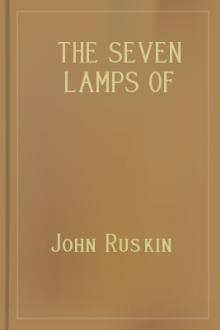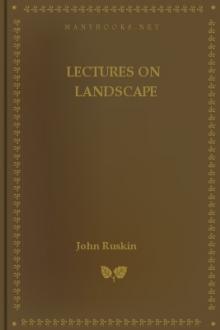The Seven Lamps of Architecture by John Ruskin (books like harry potter TXT) 📕

- Author: John Ruskin
- Performer: -
Book online «The Seven Lamps of Architecture by John Ruskin (books like harry potter TXT) 📕». Author John Ruskin
Balcony in the Campo, St. Benedetto, Venice.
XXXV. III. Our final inquiry was to be into the use of color as associated with architectural ornament.
I do not feel able to speak with any confidence respecting the touching of sculpture with color. I would only note one point, that sculpture is the representation of an idea, while architecture is itself a real thing. The idea may, as I think, be left colorless, and colored by the beholder's mind: but a reality ought to have reality in all its attributes: its color should be as fixed as its form. I cannot, therefore, consider architecture as in any wise perfect without color. Farther, as I have above noticed, I think the colors of architecture should be those of natural stones; partly because more durable, but also because more perfect and graceful. For to conquer the harshness and deadness of tones laid upon stone or on gesso, needs the management and discretion of a true painter; and on this co-operation we must not calculate in laying down rules for general practice. If Tintoret or Giorgione are at hand, and ask us for a wall to paint, we will alter our whole design for their sake, and become their servants; but we must, as architects, expect the aid of the common workman only; and the laying of color by a mechanical hand, and its toning under a vulgar eye, are far more offensive than rudeness in cutting the stone. The latter is imperfection only; the former deadness or discordance. At the best, such color is so inferior to the lovely and mellow hues of the natural stone, that it is wise to sacrifice some of the intricacy of design, if by so doing we may employ the nobler material. And if, as we looked to Nature for instruction respecting form, we look to her also to learn the management of color, we shall, perhaps, find that this sacrifice of intricacy is for other causes expedient.
XXXVI. First, then, I think that in making this reference we are to consider our building as a kind of organized creature; in coloring which we must look to the single and separately organized creatures of Nature, not to her landscape combinations. Our building, if it is well composed, is one thing, and is to be colored as Nature would color one thing—a shell, a flower, or an animal; not as she colors groups of things.
And the first broad conclusion we shall deduce from observance of natural color in such cases will be, that it never follows form, but is arranged on an entirely separate system. What mysterious connection there may be between the shape of the spots on an animal's skin and its anatomical system, I do not know, nor even if such a connection has in any wise been traced: but to the eye the systems are entirely separate, and in many cases that of color is accidentally variable. The stripes of a zebra do not follow the lines of its body or limbs, still less the spots of a leopard. In the plumage of birds, each feather bears a part of the pattern which is arbitrarily carried over the body, having indeed certain graceful harmonies with the form, diminishing or enlarging in directions which sometimes follow, but also not unfrequently oppose, the directions of its muscular lines. Whatever harmonies there may be, are distinctly like those of two separate musical parts, coinciding here and there only—never discordant, but essentially different I hold this, then, for the first great principle of architectural color. Let it be visibly independent of form. Never paint a column with vertical lines, but always cross it.13 Never give separate mouldings separate colors (I know this is heresy, but I never shrink from any conclusions, however contrary to human authority, to which I am led by observance of natural principles); and in sculptured ornaments I do not paint the leaves or figures (I cannot help the Elgin frieze) of one color and their ground of another, but vary both the ground and the figures with the same harmony. Notice how Nature does it in a variegated flower; not one leaf red and another white, but a point of red and a zone of white, or whatever it may be, to each. In certain places you may run your two systems closer, and here and there let them be parallel for a note or two, but see that the colors and the forms coincide only as two orders of mouldings do; the same for an instant, but each holding its own course. So single members may sometimes have single colors: as a bird's head is sometimes of one color and its shoulders another, you may make your capital of one color and your shaft another; but in general the best place for color is on broad surfaces, not on the points of interest in form. An animal is mottled on its breast and back, rarely on its paws or about its eyes; so put your variegation boldly on the flat wall and broad shaft, but be shy of it in the capital and moulding; in all cases it is a safe rule to simplify color when form is rich, and vice versâ; and I think it would be well in general to carve all capitals and graceful ornaments in white marble, and so leave them.
XXXVII. Independence then being first secured, what kind of limiting outlines shall we adopt for the system of color itself?
I am quite sure that any person familiar with natural objects will never be surprised at any appearance of care or finish in them. That is the condition of the universe. But there is cause both for surprise and inquiry whenever we see anything like carelessness or incompletion: that is not a common condition; it must be one appointed for some singular purpose. I believe that such surprise will be forcibly felt by any one who, after studying carefully the lines of some variegated organic form, will set himself to copy with similar diligence those of its colors. The boundaries of the forms he will assuredly, whatever the object, have found drawn with a delicacy and precision which no human hand can follow. Those of its colors he will find in many cases, though governed always by a certain rude symmetry, yet irregular, blotched, imperfect, liable to all kinds of accidents and awkwardnesses. Look at the tracery of the lines on a camp shell, and see how oddly and awkwardly its tents are pitched. It is not indeed always so: there is occasionally, as in the eye of the peacock's plume, an apparent precision, but still a precision far inferior to that of the drawing of the filaments which bear that lovely stain; and in the plurality of cases a degree of looseness and variation, and, still more singularly, of harshness and violence in arrangement, is admitted in color which would be monstrous in form. Observe the difference in the precision of a fish's scales and of the spots on them.
XXXVIII. Now, why it should be that color is best seen under these circumstances I will not here endeavor to determine; nor whether the lesson we are to learn from it be that it is God's will that all manner of delights should never be combined in one thing. But the fact is certain, that color is always by Him arranged in these simple or rude forms, and as certain that, therefore, it must be best seen in them, and that we shall never mend by refining its arrangements. Experience teaches us the same thing. Infinite nonsense has been written about the union of perfect color with perfect form. They never will, never can be united. Color, to be perfect, must have a soft outline or a simple one: it cannot have a refined one; and you will never produce a good painted window with good figure-drawing in it. You will lose perfection of color as you give perfection of line. Try to put in order and form the colors of a piece of opal.
XXXIX. I conclude, then, that all arrangements of color, for its own sake, in graceful forms, are barbarous; and that, to paint a color pattern with the lovely lines of a Greek leaf moulding, is an utterly savage procedure. I cannot find anything in natural color like this: it is not in the bond. I find it in all natural form—never in natural color. If, then, our architectural color is to be beautiful as its form was, by being imitative, we are limited to these conditions—to simple masses of it, to zones, as in the rainbow and the zebra; cloudings and flamings, as in marble shells and plumage, or spots of various shapes and dimensions. All these conditions are susceptible of various degrees of sharpness and delicacy, and of complication in arrangement. The zone may become a delicate line, and arrange itself in chequers and zig-zags. The flaming may be more or less defined, as on a tulip leaf, and may at last be represented by a triangle of color, and arrange itself in stars or other shapes; the spot may be also graduated into a stain, or defined into a square or circle. The most exquisite harmonies may be composed of these simple elements: some soft and full of flushed and melting spaces of color; others piquant and sparkling, or deep and rich, formed of close groups of the fiery fragments: perfect and lovely proportion may be exhibited in the relation





Comments (0)